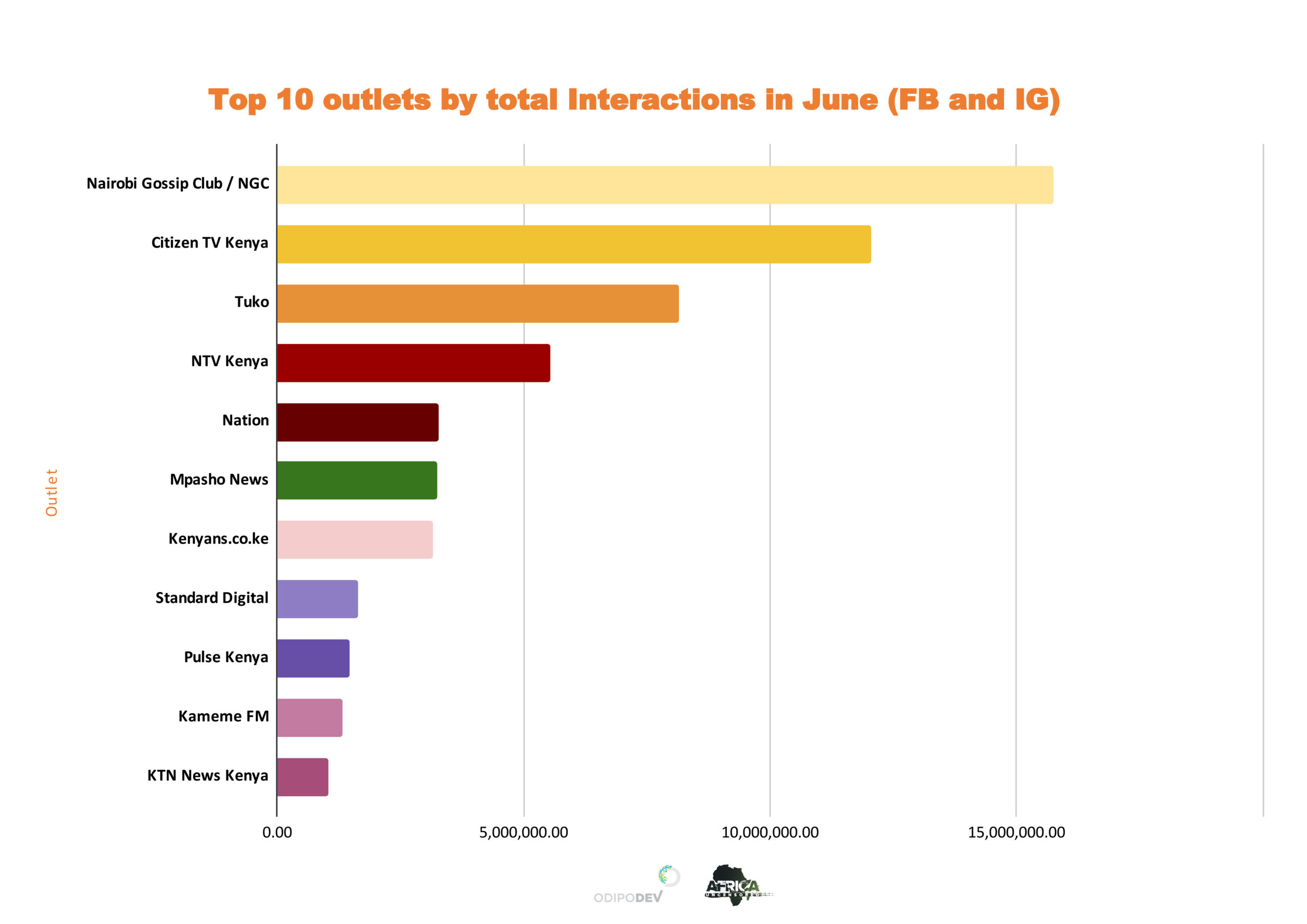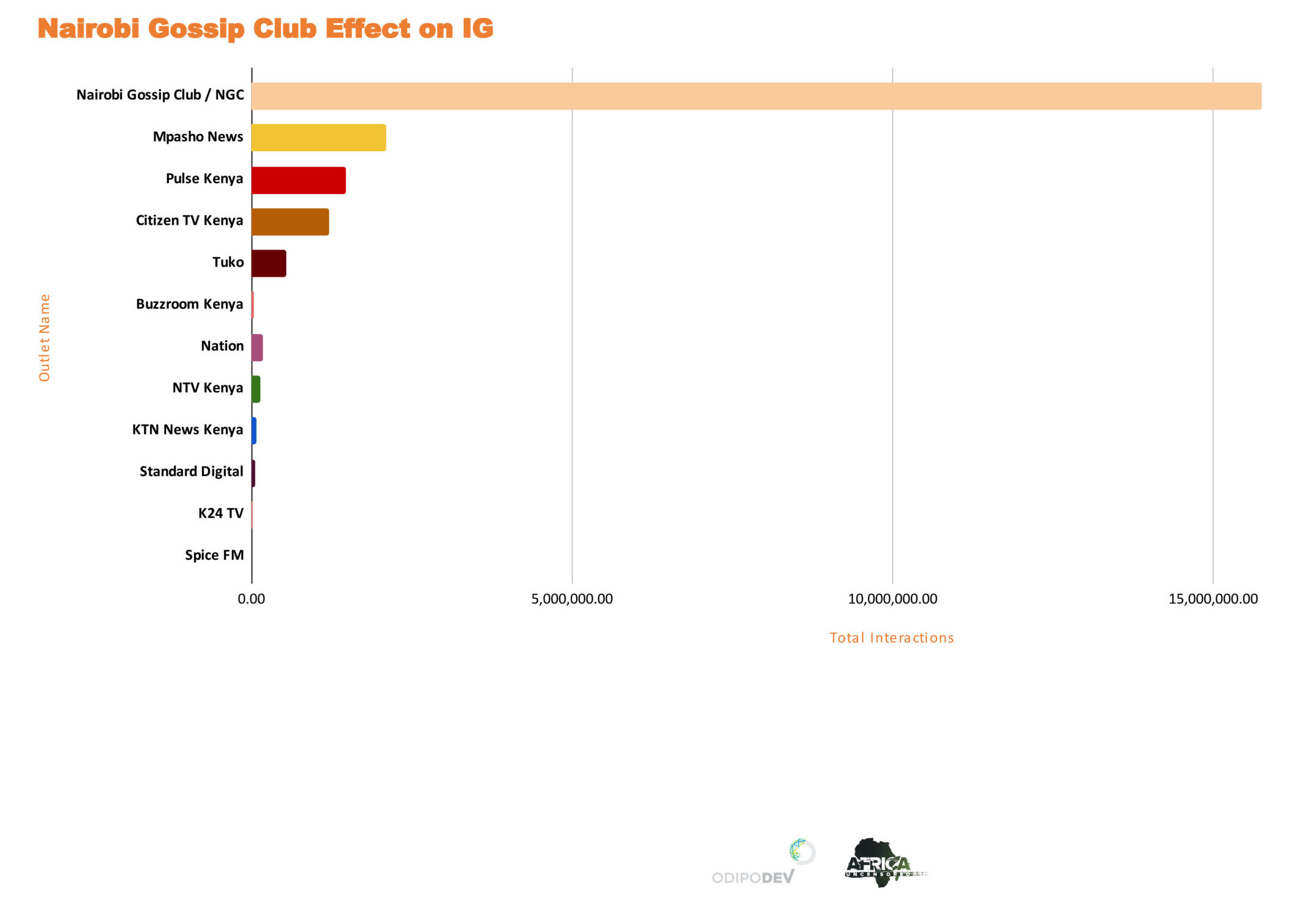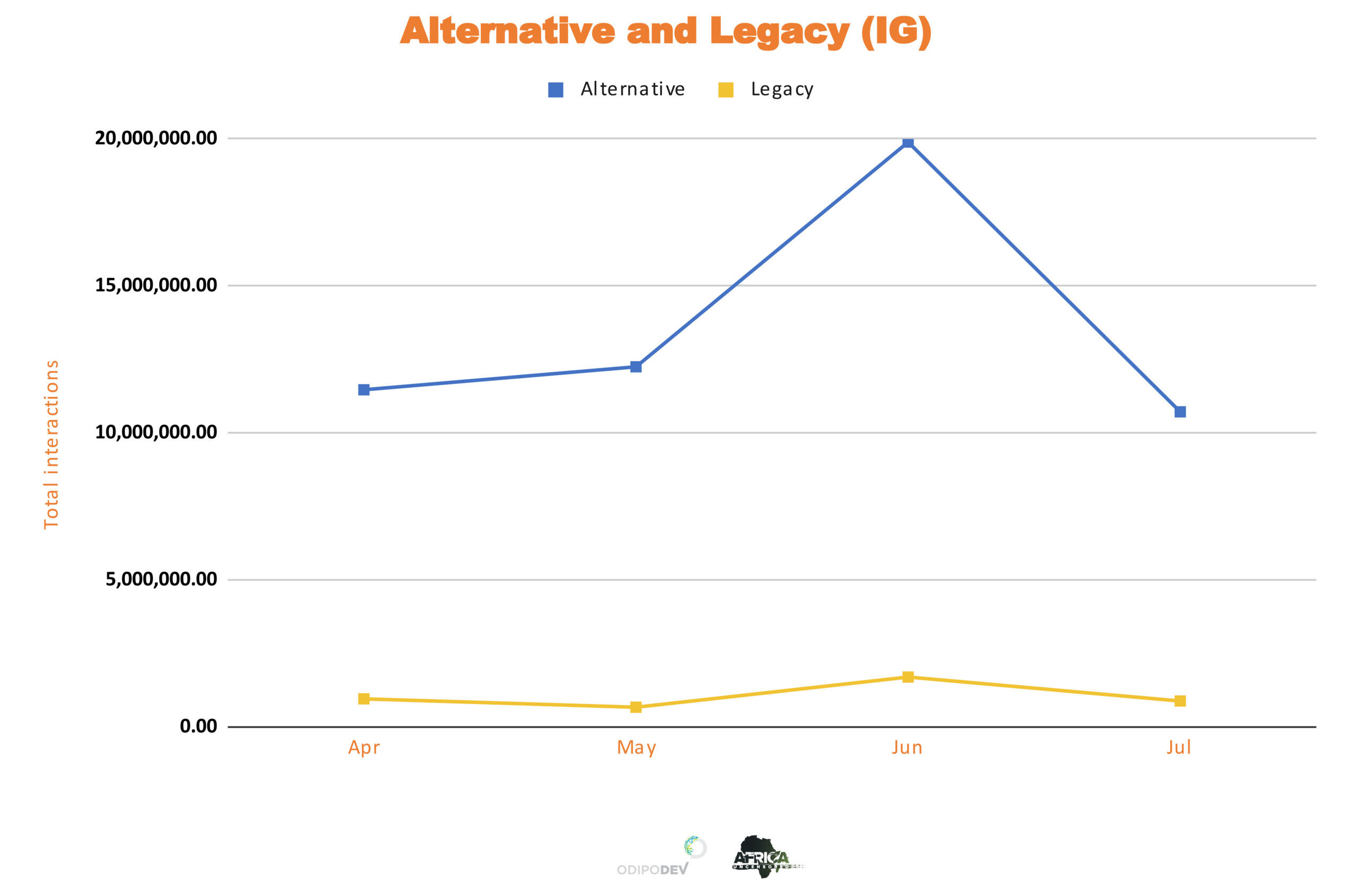By Odipo Dev
To understand the state of digital news consumption in Kenya, Odipo Dev systematically collected metadata from over 28,000 posts across the Facebook and Instagram pages of 31 English-speaking and vernacular news outlets in Kenya. The data was collected using CrowdTangle, a Meta-owned analytics tool, from May 1 to July 31, 2024 coinciding with the Gen -Z uprising in Kenya. This analysis was primarily carried out using interaction metrics (likes comments shares) on Facebook and Instagram.
When it comes to the news and where we consume it from in 2024, there’s no question that it’s largely an online phenomenon. According to research by Reuters Institute, 89% of news consumption in Kenya happens online (77% of that on social media specifically). However, what research has not revealed so far is where exactly do Kenyans find their news online?
The average Kenyan today (young, leaning female) is not a traditional seeker of news. This means that they don’t buy the paper in the morning, they don’t religiously follow the 7pm or 9pm prime time broadcast, or visit an established news website to get their news every day. The average news consumer is ‘found’ by the news. They most likely happen to bump into the day’s news as they are scrolling social media for entertainment, chatting with friends or shopping. This means only the outlets and/or personalities that penetrate this alternative activity bubble, can reach this consumer with the news.
Our research shows that this news ecosystem had a profound impact on how Kenyans followed and participated in the Gen Z protests that rocked the country earlier this year. In times of social upheaval or outstanding events like elections, citizens generally gravitate towards the news more to satisfy heightened information needs. Specifically, they seek outlets they know and trust. Our research reveals that the shape of such news outlets has drastically shifted in Kenya.
Enter Nairobi Gossip Club, Kenya’s number 1 news source across Meta’s platforms.
Our research shows that Nairobi Gossip Club (NGC) not only commands the highest number of video views and post interactions (Facebook & IG combined total) but does so by a margin that leaves Kenya’s traditional media outlets far behind. Given the significance of June 25th to Kenya’s political history, it’s striking to find that the single largest distributor of news on Meta’s platforms on that fateful day was Nairobi Gossip Club.

When you zoom in on Instagram specifically, the gap becomes significantly outsized. While Instagram may not have Facebook’s reach in Kenya, it carries significant cultural clout (alongside Tik Tok), especially among women and Gen Z. These two groups spend a large chunk of their time online between those two platforms, and it follows that if you are to reach them with the news, this is where to do it. NGC seems to understand this perfectly and in the heat of the June protests, the data shows that the platform became far and away the go-to news source on social media.
Interestingly, this goes beyond NGC; other “alternative media” outlets like Tuko, Mpasho, Pulse Kenya, Kenyans.co.ke are also outperforming legacy media brands online. Essentially, where Kenyans likely get the majority of their news from when using their phones has totally changed
How did this happen?
The unprecedented rise of NGC and other alternative media entities points at a deeper structural and cultural shift that cannot be fully explained by their editorial prowess alone.
At a structural level, the internet has evolved drastically in the last five years. Following TikTok’s outstanding success, platforms have largely taken a “For you page” approach to how they deliver content to their users. In today’s internet, algorithms have ultimate editorial power. Unlike years past, audiences don’t have to go through the burden of finding and following you to consume your content. The algorithm can propel an outlet you never knew of to the very top of your feed. This singular decision by digital platforms has had significant effects on audiences’ notions of credibility and eroded most advantages that legacy news brands may have had.
At a cultural level, these alternative news brands have established themselves as well. NGC’s name surfaces in key cultural moments and art (like in the hit song Anguka Nayo), reinforcing the idea that for urban, digitally-savvy Kenyans—many of whom took to the streets in June’s Gen Z protests—these alternative news sources are more than just gossip channels. They are not only a primary source of news and information but also embody the new idea of a national platform. While for older generations, the “Mama I made it” moment used to be when you appeared on the primetime news, for a lot of young Kenyans that moment has shifted to being featured on NGC. Or an influencer’s podcast. Or on a viral TikTok video.
The News As A Meme: Gen Z don’t view the news to be that which is solely produced by journalists
This redefined media landscape is not only shaping where news is consumed but also the content of what passes as news.
#Influencers shaped Kenya’s #GenZ protests just as much as news outlets. Our analysis shows some influencers were garnering more engagement than established news outlets during the protests. pic.twitter.com/WnU96mY43Y
— Odipo Dev (@OdipoDev) November 22, 2024
Picture this, a major event occurs in the country. The core news consumer (older, male) will be the first to hear it and most likely from traditional news outlets online and offline. But as we have already established, the average news consumer is likely not actively engaging with these outlets. Therefore, they will probably find out about the same event in a 15 seconds or less video while scrolling on Tiktok or Instagram (for funny or creative content) or as a passing mention while listening to their favorite podcasts. This kind of packaging of news has huge implications on misinformation and narrative shaping.
Enter The Influencers
Our research has long suggested that digital influencers and creators are not a passing fad—they are reshaping the way people experience media, and in Kenya, that transformation is well underway. In many ways, influencers are the quiet giants of news dissemination and political discourse, especially among women and Gen Z audiences. These groups depend on their favorite creators for more than just entertainment and product reviews. In fact, as witnessed during Kenya’s June protests, Gen Z now expect social media influencers to take a public stand on social issues.
During the protests, influencers didn’t just report on the sidelines—they became central to the conversation. On X (formerly Twitter), several hosted live Spaces, drawing in thousands of listeners, politicians and even the President at one point. On TikTok and Instagram, they went live and dropped instant commentary and real-time reactions to the day’s events. They also undertook civic education on the Finance bill and constitutional issues in digital-friendly formats. Notably, several of them were even abducted by the State.
We tracked the digital performance of three Kenyan influencers, Khalif Kairo, Murugi Munyi and Eric Omondi, who were very active during the Gen Z protests. Our data shows they garnered engagement levels comparable to Kenya’s leading media outlets on Instagram at the peak of the Gen Z uprising.
Influencers shaped the Gen Z protests just as much as news outlets did
The strength of influencers lies in how they deliver information—not as distant broadcasters, but in ways that feel personal, human, and intimate. This changes not just how people consume information but how they emotionally connect with it. More importantly, they get longer attention spans from their audiences and have built high trust with them. This means a lot of the narrative-shaping of news events is happening at this level. The news outlets report it, the influencers tell their audiences how to think and feel about it.
While they are now a mainstay in the digital ecosystem, influencers also present risks to information integrity because, as a news source, they are not held to journalistic standards and scrutiny. Instead, they will express their personal opinions on national issues, with no mandated regard for the facts and their large, loyal audiences often take up the same narratives and positions.
Vernacular media were not left behind during the uprising ,and are just as competitive as legacy media
Our research also shows that vernacular media as an avenue of news consumption is also alive and well on digital platforms. 10% of all total interactions within our database came from vernacular outlets. Not to be overlooked, these entities are achieving significant reach and actively shaping how Kenyans perceive and engage with the world. Case in point, in some instances Kameme FM and legacy English-speaking outlets are on par when it comes to audience engagement on Facebook. One entity speaks to a homogenous audience, the other speaks to a much wider demographic, showing just how much influence they wield.
Implications
- Ask audiences what they want to eat and they’ll tell you vegetables, but watch them quietly and you’ll find that they mostly eat junk food.
We’ve written previously on how the internet has flipped news & information consumption on its head, filling in the gap in fulfillment of the news needs of female audiences and youth, and how that gap has shaped the evolution of the media landscape. This gap continues to exist in 2024 and is expanding as audiences scatter to Tik Tok and podcasts.
While outlets like NGC and other alternative media may not be classified as hard news sources, they command the attention of a significant audience. How they use this power will be crucial for anyone looking to grasp where Kenyan media and political and cultural discourse are headed next.
- Your next President could be determined by X Spaces, TikTok challenges and podcasts
As Kenya heads toward the next election cycle, don’t be surprised to see politicians seek to co-opt these new media voices. We’ve witnessed this phenomenon in the recently concluded US elections, where candidates invested significant campaign effort in the new media platforms where key youth, women and minority audiences have gravitated towards. We anticipate that in Kenya’s 2027 elections, the endorsement of influential digital voices and channels will be highly sought after. The influencers’ mastery of digital-native formats like podcasts and X Spaces mixed with high audience trust, will become invaluable for reaching younger, terminally online Gen Z voters. It’s not a question of if politicians will lean into this—it’s already happening. And from the looks of it, this is only the beginning.
- Credibility is evolving and that presents some risks.
Where you get your news has a significant impact on how you understand it, your politics and general perspective of reality. During the Gen Z uprising, our data shows that it’s not only legacy news entities that experienced bumps in traffic but alternative ones as well; defying the expectation that audiences would turn to more authoritative sources of news in times of crisis and shun less credible ones. This presents a risk for the spread of misinformation or having younger audiences being entirely left out of critical national conversations.

Methodology
To understand the state of digital news consumption in Kenya, we systematically collected metadata from over 28,000 posts across the Facebook and Instagram pages of prominent English-speaking and vernacular news outlets in Kenya. The data was collected using CrowdTangle, a Meta-owned analytics tool, from May 1 to July 31, 2024 coinciding with the Gen Z uprising in Kenya.
While many of these outlets broadcast a variety of content through radio and television, their social media channels are heavily focused on the coverage and distribution of current affairs. Facebook and Instagram—two platforms under Meta’s umbrella—boast approximately 11 million users in Kenya, making them an influential force in the country’s information ecosystem. These platforms not only serve as hubs for public discourse but also shape the broader media landscape, influencing how information flows through Kenyan society.
While social media is not exhaustive of all media consumption, post-level data—when viewed in aggregate—provides a reliable indicator of public engagement with current affairs, particularly among younger audiences, who are increasingly shaping the national conversation through these digital channels.














Add comment